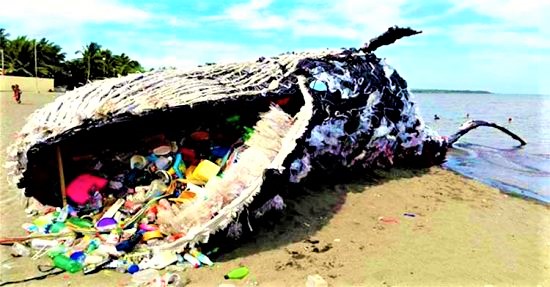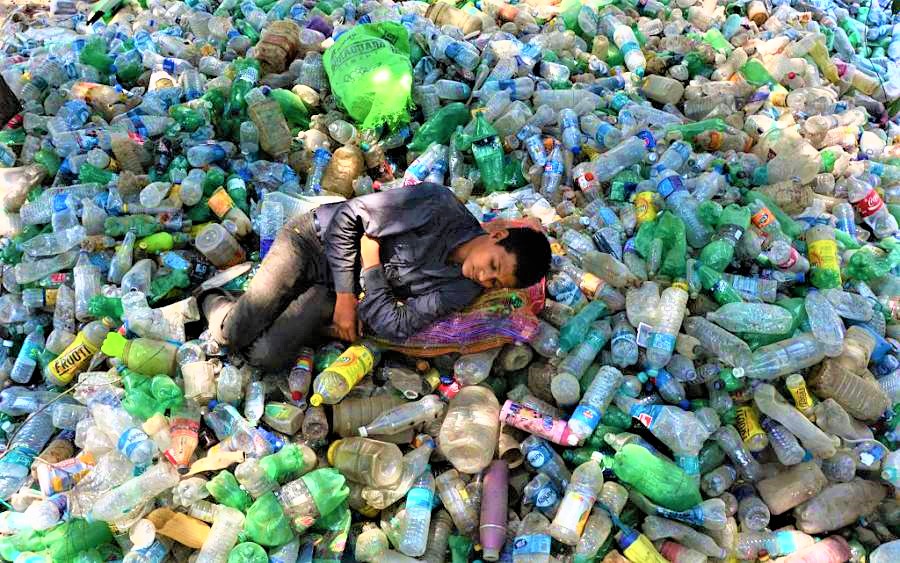Covid-19 Plastics: The Good, the Bad and the Pretty–Art from Pollution
ARTS, 7 Jun 2021
Prof Hoosen Vawda – TRANSCEND Media Service
One Person’s Thrash Is another Person’s Creativity
1 Jun 2021 – The 5th of June is observed as the World Environment Day[1] in 2021. The official message boldly states the following: – “REIMAGINE, RECREATE, RESTORE, This is our moment. We cannot turn back time. But we can grow trees, green our cities, rewild our gardens, change our diets and clean up rivers and coasts. We are the generation that can make peace with nature.” This message appears to be addressed primarily to the ordinary global citizens, but more importantly it is also addressed to the multi-nationals, large corporations who are indifferent to global pollution by single use plastics which is a new pandemic exacerbated by the SARS Cov-2 scourge. This is largely due to “stay at home” and lockdowns, when people are ordering food, online, at an unprecedented level, sealed in thick, single use plastic packaging, discarded thereafter and using plastic face shields, also adding to the non-biodegradable increase in waste during the pandemic. This is a new, emerging global challenge, which the world has either elected to be indifferent about, denied it completely, or simply not concerned about the impact of this additional non-biodegradable waste increase during the pandemic.
Furthermore, also reflect on the enormous volumes of plastic, disposable, single use gloves and other plastic Personal Protective equipment, which are often discarded randomly, adding to physical, environmental pollution, especially in waters, without any due considerations for the biohazard threat. The environmental pollution and the contribution to the global increase in the carbon footprint caused by the incineration of these additional plastics during the global medical threat of the Corona Virus is monumental and has gone unnoticed. As of Saturday, 05th June 2021, according to John Hopkins Resource Centre, there are recorded 172,621,623 total number of SARS Cov-2 infected cases, 3,713,468[2] deaths and 2,047,626,509 vaccine doses administered, using an equal millions of steel needles, with relatively large plastic fitment heads, which are then incinerated. Also reflect on the carbon generation and adding to global warming caused simply by the plastic medical needle heads, not to mention the disposable 2,047,626,509 plastic syringes used to inject the vaccine.
“Let’s get active, not anxious. Let’s be bold, not timid” and it is an opportune time to reflect on the large-scale pandemic pollution of Mother Earth, especially with plastics.
There is no doubt that plastics, in general, have saved millions of lives during the SARS Cov-2 Pandemic, being used in face shields and medical equipment such as ventilators, amongst millions of other consumables used in the war against this 21st Century plague against mankind. This is therefore a time to remind ourselves about the origins of the “Plastic Age” very much like the Stone[3], Bronze[4] and Iron Ages[5], as experienced by our early ancestors. The Plastic Age is the final era of the four-age division of the present epoch after prehistory and protohistory of humanity. It was preceded by the Iron, Bronze Age and the Stone Age (Paleolithic, Mesolithic, Neolithic, and Chalcolithic). The concept has been mostly applied to Europe and the Ancient Near East, but also, by analogy, to other parts of the Old World. Plastic age has affected every corner of the earth, including the Arctic, Antarctic and Deep Space with robotic explorers sent off to other planets in the galaxy, containing plastic components in different formulations, including new age, composite materials.[6]
The word plastic derives from the Greek πλαστικός (plastikos) meaning “capable of being shaped or molded,” and in turn from πλαστός (plastos) meaning “molded.”[7] The world’s first fully synthetic plastic was Bakelite, invented in New York in 1907, by Leo Baekeland[8] who coined the term “plastics”.[9] Dozens of different types of plastics are produced today, such as polyethylene, which is widely used in product packaging, and polyvinyl chloride, used in construction and pipes because of its strength and durability. Many chemists have contributed to the materials science of plastics, including Nobel laureate Hermann Staudinger[10], who has been called “the father of polymer chemistry” and Herman Mark, known as “the father of polymer physics”.[11]
The Plastics are a wide range of synthetic or semi-synthetic materials that use polymers as a main ingredient. Their plasticity makes it possible for plastics to be molded, extruded or pressed into solid objects of various shapes[12]. This adaptability, plus a wide range of other properties, such as being lightweight, durable, flexible, and inexpensive to produce, has led to its widespread use. Plastics typically are made through human industrial systems. Most modern plastics are derived from fossil fuel-based chemicals like natural gas or petroleum; however, recent industrial methods use variants made from renewable materials, such as corn or cotton derivatives.[13] These are the newer, bio-degradable plastics, formulated by treating cellulose, derived from cotton fiber, with camphor, John Wesley Hyatt[14] discovered a plastic that could be crafted into a variety of shapes and made to imitate natural substances like tortoiseshell, horn, linen, and ivory. This discovery was revolutionary. For the first time human manufacturing was not constrained by the limits of nature.
In developed economies, about a third of plastic is used in packaging and roughly the same in buildings in applications such as piping, plumbing or vinyl siding. Other uses include automobiles (up to 20% plastic), furniture, and toys. In the developing world, the applications of plastic may differ; 42% of India’s consumption is used in packaging. In the medical field, polymer implants and other medical devices are derived at least partially from plastic. Worldwide, about 50 kg of plastic is produced annually per person, with production doubling every ten years.
The success and dominance of plastics starting in the early 20th Century has caused widespread environmental problems, due to their slow decomposition rate in natural ecosystems. Toward the end of the 20th Century, the plastics industry promoted recycling in order to assuage environmental concerns while continuing to produce virgin plastic. The main companies producing plastics doubted the economic viability of recycling at the time, and this is reflected in contemporary plastic collection. Plastic collection and recycling is largely ineffective because of the complexity of cleaning and sorting post-consumer plastics. Most plastic produced has not been reused, either being captured in landfills or persisting in the environment as plastic pollution. Plastic pollution can be found in all the world’s major water bodies, for example, creating garbage patches in all of the world’s oceans and contaminating terrestrial ecosystems.
While Plastic Age benefitted the world, multinational companies like Unilever[15] and Coca Cola[16] are contributing significantly to plastic pollution of not only the oceans, rivers and lakes but also land, although these companies are engaged in recycling technologies.
From the farthest reaches of the Arctic to the deepest depths of the ocean, plastic pollution really is everywhere. Plastic pollution in the ocean is a particularly big problem: an estimated 100 million ocean animals are killed each year because of plastic in the ocean, and we currently have no reliable way to extract those plastics. But plastic is also a huge part of our everyday lives, in often invisible ways. One of the world’s biggest plastic polluters is racing to reinvent its business–and the way we think about this ubiquitous material–one package at a time. The sea change is top priority for Unilever to ensure customers remain loyal to the 90-year-old global brand.
On any given day, 2.5 billion people use Unilever[17] products that span 400 brands to feel good, look good and get more out of life. But the multinational with a market cap of over $158 billion recognizes that its growth has come at the expense of the environment. The company invests over $1 billion annually on research and development, of which new plastics innovation is a component, but declined to tell CNBC how much its plastics initiatives specifically are costing.
It is benefiting the company: In 2018, the 26 Unilever brands that are aligned with its sustainability initiatives grew 46% faster than the rest of the business and also outperformed in turnover growth, according to the company. It’s hard to know exactly how much of the plastic problem is due to plastic packaging, says Melanie Bergmann, a marine biologist and plastic pollution expert at Germany’s Alfred Wegener Institute. However, packaging on consumer products is a significant problem, she says, and unlike many other sources of plastic, “something we can tackle relatively easily.”[18]
Another multinational company is Coca Cola which is using single use plastic bottles since changing from refundable deposit glass bottles has contributed significant to global pollution especially in South Africa[19] Coca-Cola is shaking off environmentalists’ calls to change its packaging, saying there is too much demand for the plastic bottles.
The soft drink giant’s head of sustainability, Beatriz Perez[20], told the BBC that consumers are fans of plastic-packaged drinks because they’re able to reseal their bubbles in lightweight packaging. Doing away with plastic altogether for glass or aluminum would increase the business’s carbon footprint and weaken sales, she told the news outlet. “All packaging has a potential environmental impact, so it’s not as simple as saying one format is better than another,” said a representative.
Those statements do not make sense to environmental activists who want the company to do more than committing to making its packaging 100% recyclable by 2025 and to make bottles with an average of 50% recycled material by 2030. This will affect the taste of the contents. In South Africa, the popular soft drink is bottled by Amalgamated Beverage Industries[21] which also bottles Valpre water[22] which was recently discovered to have microplastic particles[23]. Written complaints were lodged with the company but to date no response has been received by the author, after sealed sample bottles were uplifted by the Corporate Relations Department of ABI, for analysis.
Woolworths, also another multinational in South Africa, was approached by the author on eradicating plastic pollution by banning single use plastic packaging, plastic straws and packets. All they have been successful in achieving, is to replace plastic cutlery by wooden ones, issue paper straws and stop selling their branded plastic bags[24] with multi use black canvass bags, at great expense to consumers. The single use Woolworths packaging still proliferates our oceans, rivers and streets adding to indestructible pollution. However, Woolworths is the first retailer in South Africa to announce its vision of zero packaging waste to landfill. This means that the retailer aims to have none of its packaging end up in landfills, which will require 100% recyclable materials and a supportive recycling infrastructure, which is not possible at the present.
Key to realising Woolworths’ vision include the phasing out of unnecessary single-use plastics, and the commitment for all its packaging to be either reusable or recyclable by 2022. Woolworths has also committed to phasing out single-use plastic shopping bags completely by 2020.[25] However, the author visited a Woolworths Food Hall on Environment Day and noted that the thick, molded plastic packaging is still used extensively and food items including, the farmed Norwegian Salmon is sold to customers in thick plastic packaging. Repeated e-mails to Woolworths Head Office in South Africa were met by defensive reactions from Woolworths Head of Sustainability Office.
The bad face of plastics is being played out presently, by the cargo ship, MV XPress[26] ship causing a plastic ecological disaster and environmental catastrophe in Sri Lanka, causing the pristine beaches and shores of this island nation to be contaminated with particulate plastic material nitric acid and oil. Furthermore, the sinking cargo vessel threatens to leak plastics, oil and nitric acid into the ocean. Environmentalists say impact of ecological damage could last for years. This shouldering cargo ship. carrying tonnes of chemicals is sinking off Sri Lanka’s west coast, officials said, triggering fears of an oil and chemical spill that could result in one of the worst ecological disasters the country has ever seen.
This MV X-Press Pearl, a Singapore-registered cargo ship[27], has been on fire for over two weeks now, and began sinking on 02nd June 2021,in the sea off Sri Lanka while anchored and waiting to enter the port in Sri Lanka’s capital, Colombo, when a blaze broke out on 20 May[28].
Plastics therefore are a saviour since formulation but has become a demon, generating serious pollution causing widespread destruction of sea life and a pandemic of environmental pollution, both directly and indirectly as demonstrated by the MV Xpress Pearl marine disaster
Finally, a degree of salvation for plastic lights up a glimmer of hope on the dark skies of global pollution. There is an iota of prettiness in plastic collected from the streets and thrash heaps of Sao Paolo in Brazil, which is converted into aesthetically beautiful works of art which will be permanent for the next 200 years, like Mona Lisa housed in the Louvre in Paris, France. An artist, Eduardo Srur[29] recreates art masterpieces using plastic bags collected on streets and rivers in cities[30]. He hopes to raise awareness about plastic waste and pollution. Eduardo reproduces works by renowned masters without using a drop of paint, instead he uses recycled shreds of plastic picked up from city streets and rivers. When recently interviewed, Eduardo mentioned “I make a prediction here that these works will remain for many years in the history of mankind, as well as the plastic that we inappropriately dispose of in nature. We know that the Mona Lisa is much older than 200 years. The plastics that we use will also be in nature for more than 200 years.” Eduardo has recreated works by Picasso and Edvard Munch. He will premiere his work in Sao Paulo later this year. Eduardo Srur working with his assistant Rogerio Canella hold the recreation of ‘The Scream. As shown in the graphic. For his latest exhibition, he has copied Picasso, Van Gogh, Monet and Warhol to draw attention to pollution caused by the accumulation of plastic waste, globally. “These works will remain for centuries in the history of mankind, and so will the plastic that we are dumping in nature,” he said in his Sao Paulo studio. The exhibition called “Natureza Plástica” [31] (‘Plastic Nature’) will premiere in Sao Paulo in the second half of 2021.
The artist has long worked to raise awareness about the environment, creating enormous installations in public spaces around Sao Paulo, often along the city’s heavily polluted rivers. During the coronavirus pandemic, Srur’s focus returned to the studio, where he swapped paint brushes for a pair of tweezers, working colored plastic through holes in a board to form images. He further added; “Plastic dominates everything and everyone today, so in this series I create artwork that has no paint or glue, just bits of plastic bags that end up making the image you see,” he said.
We have seen the good, the bad and the pretty of plastics in the 20th and 21st Centuries. The bottom line is that the very industries which have used plastics to grow should now concentrate on using plastics in various forms to recycle and encourage aesthetically pretty innovations from recycled plastics. This would provide employment opportunities, as well as reduce pollution generating plastics and create beauty for all to appreciate and enjoy, as well as healthy environment with a smaller carbon foot print to leave behind for future generations, to inherit.
References:
[1] https://www.worldenvironmentday.global/
[2] https://coronavirus.jhu.edu/map.html accessed on 05th June 2021 1121 hours.
[3] https://en.wikipedia.org/wiki/Stone_Age
[4] https://en.wikipedia.org/wiki/Bronze_age
[5] https://en.wikipedia.org/wiki/Iron_Age#:~:text=The%20Iron%20Age%20is%20the%20final%20epoch%20of,analogy%2C%20to%20other%20parts%20of%20the%20Old%20World.
[6] https://en.wikipedia.org/wiki/Composite_material
[7] Plastikos, Henry George Liddell, Robert Scott, A Greek-English Lexicon, at Perseus. Perseus.tufts.edu. Retrieved on 2011-07-01.
[8] American Chemical Society National Historic Chemical Landmarks. “Bakelite: The World’s First Synthetic Plastic”. Retrieved 23 February 2015.
[9] Edgar, David; Edgar, Robin (2009). Fantastic Recycled Plastic: 30 Clever Creations to Spark Your Imagination. Sterling Publishing Company, Inc. ISBN 978-1-60059-342-0 – via Google Books
[10] https://www.nobelprize.org/prizes/chemistry/1953/staudinger/biographical/
[11] https://www.acs.org/content/acs/en/education/whatischemistry/landmarks/polymerresearchinstitute.html
[12] Periodic Table of Polymers Archived 2008-07-03 at the Wayback Machine Dr Robin Kent – Tangram Technology Ltd.
[13] https://www.newshub.co.uk/science-technology/2019/12/05/biodegradable-plastic-cotton-waste/
[14] https://www.britannica.com/biography/John-Wesley-Hyatt
[15] https://www.unilever.com/
[16] https://www.coca-colacompany.com/
[17] https://www.cnbc.com/2019/07/14/global-plastic-polluter-unilevers-plan-to-stop-destroying-the-oceans.html#:~:text=%20Unilever%E2%80%99s%20plan%20to%20stop%20massive%20plastic%20pollution,is%20on%20pace%20to%20reach%20%24300…%20More%20
[18] https://www.goodreads.com/book/show/26695988-marine-anthropogenic-litter
[19] https://www.iol.co.za/news/south-africa/western-cape/coca-cola-defies-calls-to-stop-plastic-use-41332521
[20] https://www.coca-colacompany.com/company/leadership/bea-perez
[21] https://top500.co.za/top500-companies/amalgamated-beverage-industries-abi/
[22] https://www.thewaterdeliverycompany.com/2012/10/19/valpre-water-in-south-africa/#:~:text=Valpre%20Water%20in%20South%20Africa%20Valpre%20is%20Coca,manufactured%20waters%20of%20some%20distributors%20such%20as%20Nestle%29.
[23] https://www.prescouter.com/2018/03/microplastics-water-problem-solution/
[24] https://businesstech.co.za/news/business/249571/woolworths-is-ditching-its-wasteful-plastic-packaging-heres-what-is-changing/
[25] https://thenewspaper.co.za/woolworths-is-ditching-its-wasteful-plastic-packaging/
[26] https://news.sky.com/story/sri-lanka-ship-fire-sparks-fears-of-countrys-worst-marine-ecological-disaster-ever-12323790
[27] https://www.bing.com/news/search?q=sri+lanka+ship+disaster&qpvt=Sri+Lanka+Ship+disasrter&FORM=EWRE
[28] https://news.sky.com/story/sri-lanka-faces-environmental-disaster-as-chemical-laden-cargo-ship-starts-to-sink-12323067
[29] https://news.yahoo.com/brazilian-creates-works-art-plastic-065235096.html
[30] https://www.gulftoday.ae/culture/2021/06/01/brazilian-artist-eduardo-srur-conjures-works-of-art-from-plastic-bags
[31] https://www.gulftoday.ae/culture/2021/06/01/brazilian-artist-eduardo-srur-conjures-works-of-art-from-plastic-bags
______________________________________________
 Professor G. Hoosen M. Vawda (Bsc; MBChB; PhD.Wits):
Professor G. Hoosen M. Vawda (Bsc; MBChB; PhD.Wits):
Director: Glastonbury Medical Research Centre; Community Health and Indigent Programme Services; Body Donor Foundation SA.
Principal Investigator: Multinational Clinical Trials
Consultant: Medical and General Research Ethics; Internal Medicine and Clinical Psychiatry:UKZN, Nelson R. Mandela School of Medicine
Executive Member: Inter Religious Council KZN SA
Public Liaison: Medical Misadventures
Activism: Justice for All
Email: vawda@ukzn.ac.za
Tags: Art, Capitalism, Environment, Marine pollution, Microplastics, Nature's Rights, Plastic, Plastic Pollution, UN World Environment Day
This article originally appeared on Transcend Media Service (TMS) on 7 Jun 2021.
Anticopyright: Editorials and articles originated on TMS may be freely reprinted, disseminated, translated and used as background material, provided an acknowledgement and link to the source, TMS: Covid-19 Plastics: The Good, the Bad and the Pretty–Art from Pollution, is included. Thank you.
If you enjoyed this article, please donate to TMS to join the growing list of TMS Supporters.

This work is licensed under a CC BY-NC 4.0 License.


